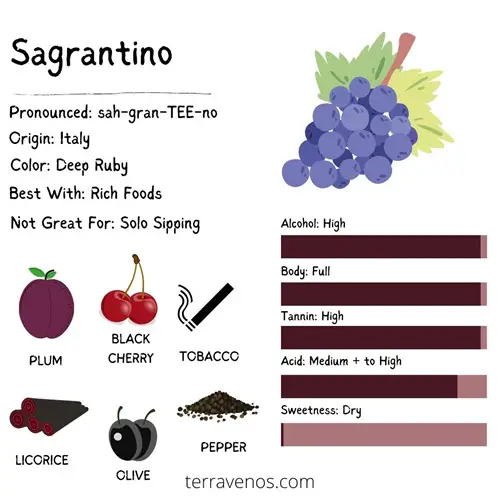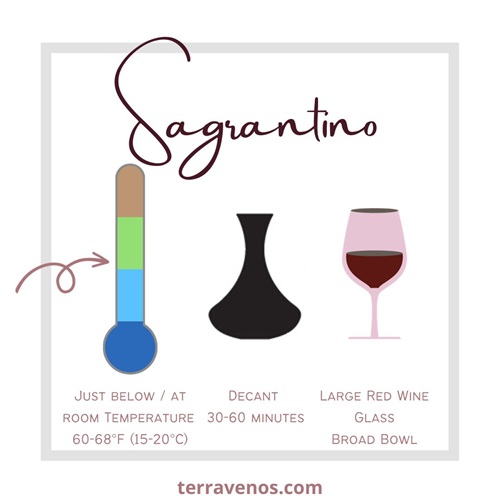Pronunciation: sah-gran-TEE-no
Sagrantino is a red wine grape from the Umbria region of Italy. Sagrantino makes robust, full-bodied, tannic, dry red wines with notes of dark fruit, leather, and spice.
Here’s what you need to know about Sagrantino wine.
- What Kind of Wine is Sagrantino?
- Where Does Sagrantino Wine Come From?
- What Does Sagrantino Smell Like?
- What Does Sagrantino Taste Like?
- What Wine Is Sagrantino Similar to?
- How to Serve Sagrantino Wine
- Can Sagrantino Wines Age?
- Sagrantino Food Pairing Suggestions
- Sagratino in the Winery
- Final Thoughts – Sagrantino as a Must-Try Red Wine Varietal
- Thirsty for More?
What Kind of Wine is Sagrantino?

Sagrantino is a full-bodied red wine with high acidity, pronounced tannins, and elevated alcohol content. Its style falls between Cabernet Sauvignon and Tannat (closer to Tannat).
Fun Wine Fact: No one knows the exact origin of the name “Sagrantino”, but it’s possibly from sagra (feast) or sacrestia (communion wine)
Where Does Sagrantino Wine Come From?
Sagrantino, deeply rooted in the winemaking traditions of Umbria, Italy, thrives in this region’s climate and terroir. It is the primary grape used in the production of the famous Sagrantino di Montefalco wines. The robust nature of Sagrantino allows it to stand on its own or contribute to blends, showcasing its versatility.
Helpful Wine Buying Tip: Look for wines with the Sagrantino di Montefalco DOCG designation for an authentic experience of this bold grape. (Here’s a quick guide to using Italy’s wine classifications to find great wines.)
Other Notable Sagrantino Growing Regions
While Umbria remains the heartland of Sagrantino, the grape has started to gain recognition beyond Italy. Some winemakers in regions such as California, Australia, and Argentina experiment with Sagrantino, crafting wines that reflect both the grape’s heritage and the influence of their respective terroirs.
What Does Sagrantino Smell Like?
Sagrantino exhibits a complex aroma profile, featuring dark fruit notes such as blackberry and plum. Additionally, you may detect hints of licorice, tea, olive, leather, tobacco, and a subtle spiciness, like black pepper, creating a layered aroma profile.
Fun Wine Fact: Sagrantino is known for its deep color and high concentration of polyphenols, contributing to its bold structure and aging potential.
What Does Sagrantino Taste Like?
Sagrantino showcases a wide range of flavors, from intense dark fruit to earthy and spicy undertones. In regions with warmer climates, expect ripe fruit flavors, while cooler climates may produce wines with more pronounced herbal and mineral notes.
On the palate, Sagrantino boasts a robust structure with high tannins, providing a grippy texture. The acidity adds a refreshing touch, balancing the wine’s richness.
Helpful Tip: Try a 30-second tasting tip on how to taste tannins in wine.
I always think that Sagrantino tends to be more intense and robust than most of your more common red varietals, making it a standout choice for bold wine enthusiasts.
Is Sagrantino Wine Dry or Sweet?
Sagrantino wines are predominantly dry, with minimal, if any, residual sugar.
What Wine Is Sagrantino Similar to?
Sagrantino Compared to Other Red Wines
| Categories | Sagrantino | Tannat | Nebbiolo | Aglianico | Merlot | Pinot Noir |
|---|---|---|---|---|---|---|
| Hue and Color | Deep purple to black | Dark red to inky black | Pale red to brick orange | Deep red to black | Ruby red | Light red to garnet |
| Sweetness | Dry | Dry | Dry | Dry | Dry to off-dry | Dry |
| Acid | High | High | High | High | Moderate | High |
| Tannin | High | High | High | High | Low to moderate | Low to moderate |
| Alcohol | High | High | High | High | Moderate | Low to moderate |
| Body | Full | Full | Medium to full | Full | Medium | Light to medium |
| Intensity | High | High | High | High | Medium | Medium to high |
| Aromas | Blackberry, plum, leather | Dark fruits, chocolate, spice | Red cherry, rose, tar | Black cherry, tobacco, earth | Red and black fruits, chocolate | Red berries, floral notes |
| Classic Regions | Montefalco, Italy | Madiran, France, Uruguay | Piedmont, Italy | Campania, Italy | Various regions | Burgundy, France |
| Average Price | $$$ | $$ | $$$ | $$ | $$ | $$$ |
Sagrantino shares similarities with other bold, tannic red wines, such as Tannat and Aglianico. Its intense flavor profile and robust structure make it a companion for those who enjoy wines with a powerful and distinctive character. Check out the chart above that compares Sagrantino to other red wines like Tannat, Nebbiolo, Merlot, and Pinot Noir.
How to Serve Sagrantino Wine

Temperature
Serve Sagrantino slightly below or around room temperature, around 60-68°F (15-20°C). This allows the wine to express its full range of aromas while maintaining a refreshing quality.
Glassware
Opt for a large, tulip-shaped glass with a wide bowl to enhance the wine’s aromas and allow for proper aeration. A big bowl will let you swirl the wine generously.
Decanting
Decant Sagrantino wines for 30-60 minutes for serving. This will allow your wine to breathe and fully develop its flavors.
Can Sagrantino Wines Age?
Sagrantino is known for its aging potential. Lighter styles can evolve over 5-10 years, while more robust versions may continue to improve for 15 years or more.
Helpful Tip: Acid, tannin, and alcohol act as preservatives to help wines age. Sagrantino has all three of these key ingredients.
Sagrantino Food Pairing Suggestions

Sagrantino’s bold and robust nature makes it an excellent companion for rich, flavorful dishes. Pair it with grilled meats, hearty stews, or aged cheeses to complement its intense profile.
Quick Tips: Sagrantino Food Pairing
- Grilled ribeye steak with a peppercorn crust
- Slow-cooked lamb shanks with rosemary
- Aged Pecorino or Parmesan cheese
Psst… Here’s what you need to know about food and wine pairing, just the basics.

Notable Sagrantino Producers and Bottles to Try
When exploring Sagrantino, seek out producers dedicated to showcasing the grape’s bold personality. Some notable wineries include:
- Arnaldo Caprai (Umbria, Italy),
- Tabarrini (Umbria, Italy), and
- Scacciadiavoli (Umbria, Italy)
Fun Wine Fact: It’s believed that Sagrantino has a rich history dating back to Roman times and was referenced by Pliny the Elder (the original foodie).
Sagratino in the Winery
Sagratino wines are big wines, so winemakers work with the grapes to make the wine more approachable when it’s released for sale, including long aging in oak barrels. Sagrantino is also used in blends with Sangiovese.
Fun Wine Fact: Montefalco Sagrantino must be made entirely from Sagrantino grapes and requires a minimum of 37 months of aging before release, 12 of which must be in oak barrels.
Final Thoughts – Sagrantino as a Must-Try Red Wine Varietal
With its intense flavors, robust structure, and aging potential, Sagrantino is a wine that demands attention and appreciation. Here are three key takeaways to remember:
- Distinctive Flavor Profile: Sagrantino offers a bold mix of dark fruit, spice, and earthy notes. Its high tannins and acidity contribute to a powerful and lasting finish.
- Food-Pairing Excellence: Sagrantino’s intensity pairs well with rich, flavorful dishes, making it a versatile choice for a variety of cuisines.
- Regional Authenticity: The heartland of Umbria, Italy, remains the prime region for experiencing Sagrantino in its truest form.
Thirsty for More?
Discover more big red wines to broaden your palate.
Check out Nero d’Avola next, another big red wine from Italy’s Island of Sicily, that’s underrated.




